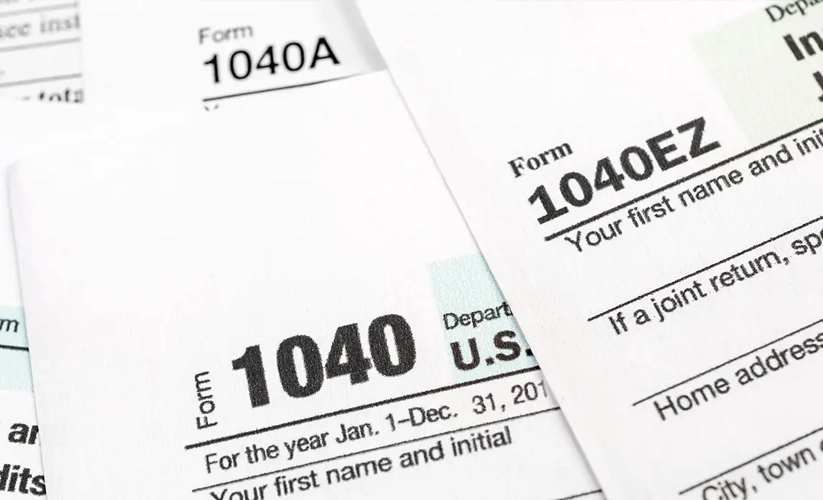
EZ come, EZ go.
Filing income taxes can be a daunting task, but luckily, the IRS provides various tax forms to cater to different taxpayer needs.
Sometimes, they join the best parts of several federal tax form and reduce them to its simplest form, while offering more filing status choices, deduction options, and more for those times when you aren’t filing a simple tax return.
Let’s explore why the IRS has decided not to offer the 1040 EZ for the year 2023.
Simplified Version for Basic Tax Situations:
The 1040 EZ was a simplified version of the standard Form 1040. It is tailored to individuals who do not have any dependents and have relatively straightforward tax situations. By condensing the necessary information, the 1040 EZ makes the filing process faster and less complicated for those eligible to use it.
No Tax Form 1040 EZ for 2023:
For the year 2023, the IRS has eliminated the 1040 EZ form. This decision was likely made to streamline the tax filing process and encourage taxpayers to use the standard Form 1040. The standard form accommodates a broader range of tax situations, everything you need for your standard deductions and any income tax credit.
Although the 1040 EZ is not available for the year 2023, an income tax filer can get their tax refund without much work just by using the regular 1040 form for their federal return. By accurately reporting all relevant information, taxpayers can take advantage of the available tax credits and deductions that cater to their unique financial situations. Filing taxes may still be a daunting task, but with the correct form and proper understanding, it can be successfully completed with ease.
The Tax Form 1040 EZ Was Retired in 2018
The tax form 1040 EZ was retired in 2018, and taxpayers are now required to use the standard Form 1040 for their federal income tax returns. To be eligible to use the 1040 EZ form in previous years, individuals had to meet certain criteria.
Firstly, their filing status had to be either Single or Head of Household. Married individuals filing jointly or separately were not eligible to use this form.
Secondly, there were income limitations. Taxpayers could only use the 1040 EZ form if their taxable income was below a certain threshold. This threshold varied each year and was typically lower than for the standard Form 1040.
Lastly, age restrictions were in place. Individuals had to be under the age of 65 and not blind. If they were 65 or older, or blind, they had to use the standard Form 1040.
Additionally, the 1040 EZ form had restrictions on deductions and credits. Taxpayers could not itemize deductions or claim certain tax credits, such as the Earned Income Credit or the Education Credits.
1040 vs 1040 EZ: What Made the 1040 EZ Different?
There were significant differences between tax forms 1040 and 1040 EZ, making them cater to different types of taxpayers with varying income categories and tax circumstances. While form 1040 EZ was designed for individuals with basic tax situations, form 1040 was more comprehensive and suitable for taxpayers with more complex financial circumstances.
Form 1040 EZ had strict eligibility criteria. Taxpayers had to be either Single or Head of Household, with no option for married individuals filing jointly or separately. Additionally, there were age restrictions, as individuals had to be under the age of 65 and not blind.
Income limitations were another key difference. Only taxpayers with taxable income below a specific threshold could use form 1040 EZ, e. This threshold varied each year and was generally lower than for the standard Form 1040.
Form 1040 EZ also had restrictions on deductions and credits. Taxpayers could not itemize deductions or claim certain tax credits, such as the Earned Income Credit or the Education Credits. This made the form suitable for individuals with basic income categories and fewer tax credits and deductions.
On the other hand, form 1040 allowed taxpayers to claim a wider range of deductions and credits, including itemized deductions for expenses like mortgage interest and charitable contributions.
The IRS Discontinued Form 1040A, Too. Here’s Why.
The IRS announced the discontinuation of Form 1040A, one of the simplest tax forms used by taxpayers with basic tax situations. This decision was made in an effort to streamline the tax filing process and simplify the options available to taxpayers.
Form 1040A was eliminated as part of the Tax Cuts and Jobs Act, which aimed to simplify the tax code and reduce the number of tax forms. Prior to its discontinuation, Form 1040A was often used by taxpayers who had taxable income, but did not qualify for certain tax credits or deductions.
Compared to other tax forms, Form 1040A had some distinct differences. It allowed taxpayers to claim the standard deduction, but did not offer the option to itemize deductions. It was also limited in terms of the types of income that could be reported, excluding certain sources such as rental income and foreign income.
Despite its simplicity, Form 1040A also had limitations. It did not allow taxpayers to file as “married filing separately” or “head of household.” Additionally, it did not provide the same level of flexibility when it came to reporting income and claiming deductions.
Which 1040 Should You Use?
While the 1040 EZ form was retired in 2018, taxpayers must now use the standard Form 1040 for their federal returns. To determine which form is best for you, consider your filing status, income level, age and the deductions or credits you may be eligible to claim. Ultimately, understanding your financial circumstances and consulting with a tax professional can help you make an informed decision when choosing the right form to file with.
Which Taxpayers Used 1040 EZ?
The 1040 EZ tax form was designed for individuals with basic tax situations. Taxpayers who met specific criteria and eligibility requirements could use this simplified for their federal income tax returns.
This form is ideal for individuals who have straightforward income sources such as wages, salaries, tips, and unemployment compensation. It also covers interest income below a certain threshold, as well as limited dividend payments. Taxpayers using the 1040 EZ form can claim the standard deduction, which is a set amount for each filing status. They are not able to itemize deductions or claim specific tax credits, such as the earned income credit or education credits.
What Other Types of 1040 Tax Forms Exist? What Are They For?
The 1040 tax form, commonly known as the 1040 EZ form, is a simplified version of the regular 1040 form designed for individuals with straightforward tax situations. However, there are other types of 1040 tax forms available for taxpayers with different circumstances. These forms cater to varying filing statuses, types of income, deductions, and credits. Understanding the different types of 1040 tax forms is crucial to accurately reporting income, claiming deductions, and maximizing tax benefits. Let’s explore the other types of 1040 tax forms and learn about their specific purposes.
The 1040A tax form is a middle-ground option for individuals who have more complex tax situations compared to what the 1040 EZ form allows, but still don’t require the full extent of the regular 1040 form. It offers more tax benefits and allows for additional adjustments, credits, and deductions. Taxpayers who have more types of income such as capital gains, taxable scholarships, or dividend payments can use the 1040A form. Additionally, those who have retirement income or earned income credit can benefit from this form.
The regular 1040 tax form is the most comprehensive version, accommodating all types of income and deductions. It is suitable for taxpayers who have complex tax situations, such as those with self-employment income, foreign income, or rental income. It also allows for itemized deductions, making it advantageous for individuals who can claim higher deductions than the standard amount.
Form 1040 SR
Form 1040 SR, also known as the U.S. Tax Return for Seniors, is a tax form specifically designed for taxpayers who are 65 or older. It serves the same purpose as Form 1040, which is to report a taxpayer’s taxable income and calculate their federal income tax. However, Form 1040 SR includes some additional features and benefits for seniors.
To be eligible to use Form 1040 SR, you must be at least 65 years old by the end of the tax year and have a U.S. citizenship or residency status. This form is similar to Form 1040 in many ways, but it caters specifically to the needs of older taxpayers.
One of the key features of Form 1040 SR is the larger font size, which makes it easier to read and fill out for seniors with visual impairments. Additionally, the form includes a standard deduction table right on the form, eliminating the need to refer to separate instructions or tables.
By using Form 1040 SR, seniors can conveniently report their income and deductions, including sources such as social security benefits, retirement income, and rental income. They can also claim tax credits and deductions, such as the premium tax credit and loan interest deductions.
Form 1040 NR
Form 1040 NR is a tax form designed specifically for nonresident aliens who are required to file a U.S. tax return. This form is used by individuals who do not qualify as U.S. residents for tax purposes but have income from U.S. sources.
Unlike other tax forms, Form 1040 NR has its own set of eligibility criteria and purpose. It is important to note that nonresident aliens must meet certain conditions in order to use this form. These conditions include not having a green card or meeting the substantial presence test, which determines if an individual has a significant presence in the U.S. during a specific period.
Form 1040 NR is specifically tailored to report income earned from U.S. sources, such as wages, salaries, tips, dividends, and rental income. Nonresident aliens must accurately report their income and deductions through this form to determine their taxable income and potential tax liability.
It is crucial for nonresident aliens to carefully navigate the tax filing process and ensure compliance with U.S. tax laws. Utilizing Form 1040 NR allows individuals to fulfill their tax obligations and avoid any potential penalties for failing to file a U.S. tax return.
In conclusion, Form 1040 NR is an essential tax form for nonresident aliens who have income from U.S. sources but do not qualify as U.S. residents for tax purposes. By accurately reporting their income and deductions through this form, individuals can fulfill their tax obligations and avoid any potential repercussions.

Markos Banos
Markos M. Baños Cabán, Esq., is the Director of Resolutions at Community Tax LLC, where he leads a team of practitioners and service professionals dedicated to resolving complex tax conflicts, including IRS audits, tax liens, and tax debt. A licensed attorney, tax practitioner, and notary public in Puerto Rico, Markos combines his extensive legal expertise and management skills to deliver exceptional results and reduce stress for his clients. He holds a Juris Doctor from the University of Puerto Rico School of Law and has experience in a variety of legal fields, as well as industrial management. Bilingual in English and Spanish, Markos is also a published researcher with a passion for delivering outstanding service.







